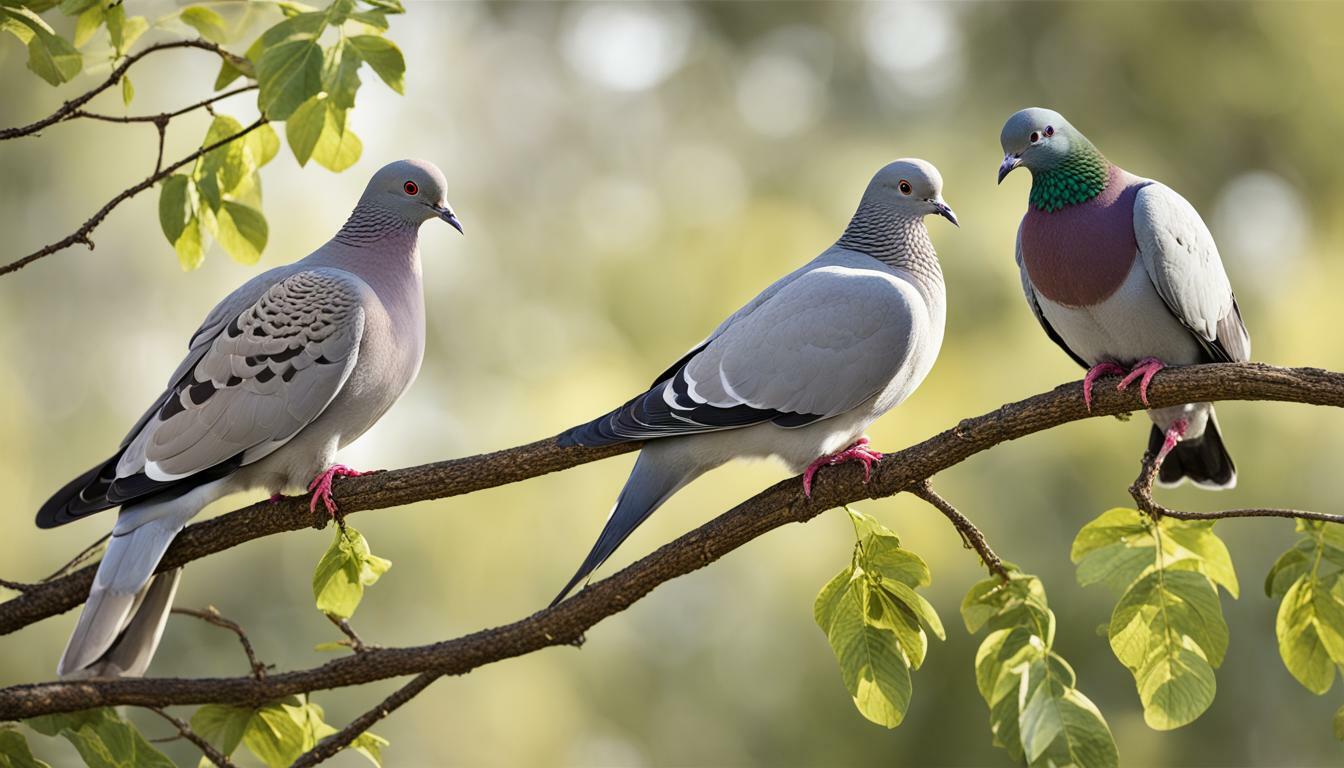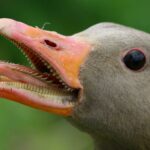As a bird enthusiast, it is important to understand the difference between doves and pigeons. While they may seem similar at first glance, there are distinct characteristics and behaviors that set them apart.
Doves and pigeons both belong to the Columbidae family, but they are different species. Doves are smaller and slimmer with a more delicate appearance, while pigeons are larger and more robust.
Let’s explore the key differences between doves and pigeons:
Key Takeaways:
- Doves and pigeons are separate species within the Columbidae family.
- Doves are smaller and have a more delicate appearance, while pigeons are larger and more robust.
- Understanding the differences between doves and pigeons is important for bird enthusiasts and nature lovers.
Distinguishing Doves from Pigeons: Physical Appearance and Size
While it is sometimes difficult to differentiate doves from pigeons, there are certain physical characteristics that can help you tell them apart. Doves tend to be smaller and slimmer than pigeons, with a more delicate appearance. Their beaks are also shorter and narrower than those of pigeons.
Doves have a distinct body shape, with a rounded head and a streamlined, slender body. They also have a long tail that serves as a rudder when flying. Pigeons, on the other hand, have a plumper, bulkier build, with a larger head and a shorter tail.
Another key difference between the two species is their coloration. Doves are typically gray or brown, with muted colors and subtle patterns. Pigeons, on the other hand, can come in a wide variety of colors and patterns, including iridescent and metallic hues. Some species of pigeons even have distinct feather crests on their heads.
So, if you’re trying to differentiate doves from pigeons, keep an eye out for these physical characteristics. Doves are typically smaller, slimmer birds with shorter, narrower beaks and a more delicate appearance. They also have a rounder head and a longer tail than pigeons. Pigeons, on the other hand, are generally larger and bulkier, with broader beaks and a plumper build.
Habitat and Distribution
If you’re interested in differentiating doves from pigeons, understanding their habitat and distribution preferences can be helpful. Generally, pigeons are found in more urban environments, while doves prefer rural and suburban areas.
Pigeons are known for their adaptability to city life and can be found in large urban centers across the United States. On the other hand, doves can be seen in a variety of habitats including forests, deserts, grasslands, and even in some coastal areas.
There are also differences in the geographical distribution of doves and pigeons. Pigeons are found worldwide, while doves are more regionally limited. Mourning doves, for example, are found throughout North America, while the African collared dove is found primarily in sub-Saharan Africa.
Feeding Habits
When comparing doves and pigeons, it’s important to understand the distinction in their feeding habits. While both species will eat seeds, fruits, and insects, doves tend to have a more specialized diet. Doves primarily consume seeds and grains, while pigeons are known to eat a wider variety of food, including human scraps and even small animals like worms and snails.
Another key difference is in their feeding behaviors. Doves are typically ground feeders, meaning they forage for food on the ground. Pigeons, on the other hand, are able to forage for food in trees and other elevated locations.
It’s worth noting that both doves and pigeons are known to be attracted to bird feeders, especially if they contain seeds or grains. If you want to attract doves specifically, consider offering a mix of millet, sunflower seeds, and cracked corn. Pigeons will also enjoy these foods, but may appreciate additional options like bread or cooked rice.
Vocalizations and Communication
Both doves and pigeons are known for their distinctive vocalizations, which can vary between species. However, there are also similarities in their communication methods.
Doves typically coo softly, whereas pigeons are known for their cooing that can be heard from a distance. Both species use their calls to communicate with others and establish their territory.
During courtship, doves and some pigeon species perform a display flight to attract a mate. They will fly in circles while flapping their wings and cooing loudly. This display is often accompanied by the puffing up of feathers and the bobbing of the head.
Both doves and pigeons also communicate through body language. They may use certain postures and movements to convey dominance or submission to others of their species. For example, doves will often bow their head and spread their tail feathers to show submission, while pigeons may puff up their chest and walk stiff-legged to assert dominance.
Understanding the similarities and differences in vocalizations and communication can help bird enthusiasts identify and appreciate these fascinating species.
Behavior and Social Structure
Doves and pigeons exhibit a variety of unique behaviors and social structures. For instance, doves are more solitary than pigeons and tend to mate for life. Pigeons, on the other hand, are more social and tend to live in flocks.
Both doves and pigeons build nests and are known for their unique mating rituals. Doves often perform a cooing display to attract potential mates, while pigeons create a “nest scrape” and bow to each other as part of their courtship.
Interestingly, both species are known to exhibit a specific type of behavior known as “head-bobbing.” This motion is often accompanied by a vocalization and is thought to be a way for birds to assert dominance.
In terms of social hierarchy, pigeons have a clear dominance hierarchy within their flocks, while doves tend to be more egalitarian and less hierarchical.
Adaptability and Human Interaction
When it comes to adapting to human environments and interacting with humans, there are distinct differences between doves and pigeons. While both species can be found in urban settings, pigeons have a greater ability to thrive and survive in cities due to their scavenger nature. Pigeons have learned to coexist with humans and take advantage of the food and shelter they provide.
Doves, on the other hand, are less likely to venture into urban areas and are more commonly found in rural or suburban environments. They prefer to live in natural habitats, such as forests and woodlands, where they can find food and shelter without human interference.
Understanding the distinction between doves and pigeons in terms of adaptability and human interaction is important for wildlife management and conservation efforts. While pigeons may be viewed as pests by some, they play an important role in urban ecosystems and should be treated with respect and care. Doves, on the other hand, are a symbol of peace and are often admired for their beauty and grace.
Conclusion
Identifying the differences between doves and pigeons is important for anyone interested in bird watching or studying avian species. Although these two bird species may look similar at first glance, their physical characteristics, behaviors, and habitats are distinct. By understanding these differences, you can become an expert in distinguishing between doves and pigeons. To recap, doves are generally smaller in size than pigeons and have longer tails with pointed tips. They prefer to live in wooded areas, while pigeons are often found in urban environments. Doves tend to eat seeds and fruits, while pigeons have a more varied diet. Doves also have a softer cooing sound, while pigeons make a distinctive cooing noise. In conclusion, if you want to distinguish between doves and pigeons, pay attention to their physical appearance, habitat, feeding habits, vocalizations, and social behaviors. By doing so, you can become an expert in identifying these two species and enjoy observing their unique characteristics.Do Blue Jays and Doves have similar migration patterns?
Blue jay migration patterns explained: While both Blue Jays and Doves migrate, their patterns differ. Blue Jays are known for their long-distance migratory behavior, traveling south to avoid harsh winters. In contrast, Doves are mainly sedentary, with some populations undertaking short-distance movements. These distinct migration behaviors contribute to the unique ecological roles these bird species play in their respective habitats.
FAQ
Q: What are the main differences between doves and pigeons?
A: Doves and pigeons are closely related bird species, but there are several key differences between them. Doves are generally smaller in size and have a more delicate appearance compared to pigeons. They also have a slightly different coloration, with doves often having a lighter, softer color palette.
Q: How can I differentiate between doves and pigeons based on their physical appearance?
A: One way to differentiate between doves and pigeons is by looking at their physical characteristics. Doves tend to have a slender body shape and a small head with a pointed beak. Pigeons, on the other hand, have a larger body, a stockier build, and a more prominent, rounded head.
Q: Where can I find doves and pigeons in terms of their habitat and distribution?
A: Doves and pigeons have different habitat preferences and geographical distributions. Doves are commonly found in wooded areas, gardens, and parks. Pigeons, on the other hand, are known for their adaptability to urban environments and can be found in cities all around the world.
Q: What do doves and pigeons eat?
A: Doves and pigeons have similar diets, primarily consisting of seeds, grains, fruits, and vegetation. However, pigeons are often more opportunistic and may scavenge for food in urban areas.
Q: How do doves and pigeons communicate with each other?
A: Doves and pigeons use vocalizations and body language to communicate. They make cooing sounds, which can vary in tone and rhythm depending on the situation. They also engage in various visual displays, such as puffing up their feathers or bobbing their heads.
Q: What are some behaviors and social structures unique to doves and pigeons?
A: Doves and pigeons are known for their strong pair bonds and monogamous mating systems. They build nests in trees, buildings, or other structures. Doves are often more solitary and prefer solitude, while pigeons are more social and tend to gather in larger flocks.
Q: How do doves and pigeons interact with humans?
A: Both doves and pigeons have adapted well to human environments. They can be found in urban areas, parks, and gardens, where they often rely on humans for food sources. While pigeons are more commonly associated with urban settings, doves can also be seen in suburban areas.











